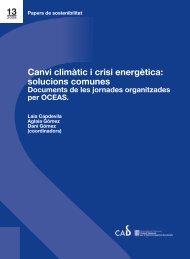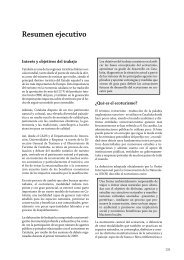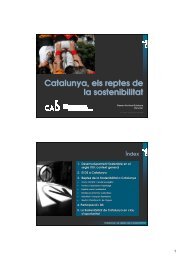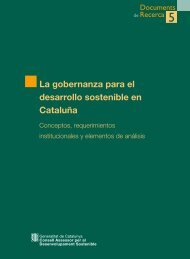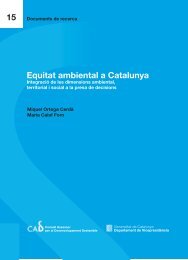Estratègies per al desenvolupament sostenible - Generalitat de ...
Estratègies per al desenvolupament sostenible - Generalitat de ...
Estratègies per al desenvolupament sostenible - Generalitat de ...
You also want an ePaper? Increase the reach of your titles
YUMPU automatically turns print PDFs into web optimized ePapers that Google loves.
It is <strong>al</strong>so important to i<strong>de</strong>ntify stakehol<strong>de</strong>r interests, relations and powers. Onan issues basis, it is necessary to un<strong>de</strong>rstand questions such as stakehol<strong>de</strong>rmotivations and interests in relation to the issue; the rights, resources, and othermeans and powers that are available to them (or that are missing) to pursuetheir motivations and interests; the extern<strong>al</strong> pressures on them to change; their<strong>de</strong>gree of acceptance of need for change –or resistance against it–; the constraintsto making changes, such as regulatory, bureaucratic and resource constraints.Particular sustainability issues are usu<strong>al</strong>ly characterized by stakehol<strong>de</strong>r conflictor, <strong>al</strong>ternatively, <strong>al</strong>liances. Such relationships may need to be explored further.Particularly, in relation to structuring an NSSD it is useful to ascertain whichstakehol<strong>de</strong>rs have similar positions on an issue and work together to pursuetheir common interests –the “policy communities” or networks that may existin form<strong>al</strong> or inform<strong>al</strong> senses– and the kinds of initiatives they have worked ontogether. Such policy communities can often provi<strong>de</strong> much momentum for astrategy process if linked to it.An assessment of the particular powers (or lack of them) of stakehol<strong>de</strong>rs is <strong>al</strong>socruci<strong>al</strong> both to an un<strong>de</strong>rstanding of each sustainable <strong>de</strong>velopment issue (whoare the dominant and the margin<strong>al</strong>ized), and to the structuring of strategyprocesses (who needs to be involved to remedy problems and re<strong>al</strong>izeopportunities). For strategy an<strong>al</strong>ysis, a useful first step is to i<strong>de</strong>ntify the relative<strong>de</strong>gree of stakehol<strong>de</strong>r power, the source of that power and the means by whichpower is exercised. It is important to address the question of how stakehol<strong>de</strong>rsgain or lose power to influence the direction of the policy process.The next ch<strong>al</strong>lenge is to relate the power of stakehol<strong>de</strong>rs to their potenti<strong>al</strong> toaffect, or be affected by, strategies and related policies, institutions and initiatives.Assessing which individu<strong>al</strong>s and groups have power over which others will helpto piece together power chains –often the potenti<strong>al</strong> to affect policy, institutionsand initiatives is not <strong>de</strong>rived through one direct link, but through a chain–. Ofparticular concern are those stakehol<strong>de</strong>rs with high potenti<strong>al</strong> for sustainable<strong>de</strong>velopment but little power (such as landless people). If progress towardssustainable <strong>de</strong>velopment is to be ma<strong>de</strong>, some stakehol<strong>de</strong>rs need to beempowered to make more positive contributions, while others need to berestrained from making <strong>de</strong>structive contributions.144




